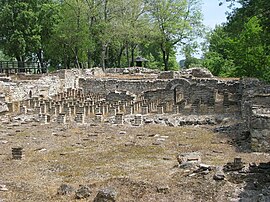Dion, Macedonia
|
Dion Δίον |
|
|---|---|

Hypocaust of ancient public baths
|
|
| Coordinates: 40°10′N 22°29′E / 40.167°N 22.483°ECoordinates: 40°10′N 22°29′E / 40.167°N 22.483°E | |
| Country | Greece |
| Administrative region | Central Macedonia |
| Regional unit | Pieria |
| Municipality | Dio-Olympos |
| • Municipal unit | 172.743 km2 (66.696 sq mi) |
| Elevation | 40 m (130 ft) |
| Population (2011) | |
| • Municipal unit | 10,885 |
| • Municipal unit density | 63/km2 (160/sq mi) |
| Community | |
| • Population | 1,424 (2011) |
| • Area (km2) | 31.375 |
| Time zone | EET (UTC+2) |
| • Summer (DST) | EEST (UTC+3) |
| Postal code | 601 00 |
| Area code(s) | 23510 |
| Vehicle registration | KN |
Dion or Dio (Ancient Greek: Δίον, Greek: Δίο, Latin: Dium) is a village and a former municipality in the Pieria regional unit, Greece. Since the 2011 local government reform, it is part of the municipality Dio-Olympos, of which it is a municipal unit. It is located at the foot of Mount Olympus.
It is best known for its great ancient Macedonian sanctuary of Zeus and city, much of which is visible in the archaeological park and the Archaeological Museum of Dion.
The ancient city owes its name to the most important Macedonian sanctuary dedicated to Zeus (Dios, "of Zeus"), leader of the gods who dwelt on Mount Olympus; as recorded by Hesiod's Catalogue of Women, Thyia, daughter of Deucalion, bore Zeus two sons, Magnes and Makednos, eponyms of Magnetes and Macedonians, who dwelt in Pieria at the foot of Mount Olympus. Hence from very ancient times, a large altar had been set up for the worship of Olympian Zeus and his daughters, the Muses, in a unique environment characterised by rich vegetation, towering trees, countless springs and a navigable river. For this reason Dion was the "sacred place" of the Ancient Macedonians. It was the place where the kings made splendid sacrifices to celebrate the new year of the Macedonian calendar at the end of September. In the Spring, purification rites of the army and victory feasts were held.
...
Wikipedia


